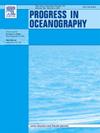Impact of climate change on the distribution of potentially suitable habitat areas for major catch fish in the Beibu Gulf, South China Sea
IF 3.6
3区 地球科学
Q1 OCEANOGRAPHY
引用次数: 0
Abstract
Climate change can hamper or imbalance marine ecological functions, thereby reducing marine resources and changing their spatial distribution patterns. To further understand the impact of climate change on the spatial distribution patterns of marine organisms, this study analyzed 10 major catch fish species (category) found in the Beibu Gulf and used the MaxEnt model to explore their distribution from 2006 to 2018 based on the surveys conducted by 26 cruises on bottom trawl fishery stocks in the Beibu Gulf and five environmental factors. The spatial distribution pattern and centroid movement trends in three different CO2 emission scenarios in RCP2.6 (2041–2060) and RCP8.5 (2041–2060) were also determined. The results demonstrated that the mean area under the curve for current, RCP2.6, and RCP8.5 scenarios were 0.898, 0.897, and 0.896, respectively, indicating the reliable performance of the model. The total area suitable for Sciaenidae was reduced in RCP2.6, indicating that this might be a loser taxon. The RCP8.5 climate scenario revealed an increase in the total area suitable for the 10 major catch fish species (category), indicating that they might be winner taxa. The rates of expansion, contraction, and centroid change in their potential habitats were generally higher in RCP8.5 than in RCP2.6. The mean shift rates in the RCP2.6 and RCP8.5 scenarios were 5.79 km/10(a) and 6.14 km/10(a), respectively. Centroid analysis conducted based on future climate change patterns revealed that migration direction would be initially toward north, which would then shift to south.
气候变化对南海北部湾主要鱼类潜在适宜栖息地分布的影响
气候变化会阻碍或失衡海洋生态功能,从而减少海洋资源并改变其空间分布格局。为进一步了解气候变化对北部湾海洋生物空间分布格局的影响,本研究基于对北部湾26次底拖网渔业种群的调查和5个环境因素,分析了北部湾10种主要捕捞鱼类(类别),并利用MaxEnt模型探讨了2006 - 2018年北部湾底拖网渔业种群的分布情况。确定了RCP2.6(2041—2060)和RCP8.5(2041—2060)3种不同CO2排放情景下的空间分布格局和质心运动趋势。结果表明,当前、RCP2.6和RCP8.5情景下的平均曲线下面积分别为0.898、0.897和0.896,表明模型性能可靠。在RCP2.6中,Sciaenidae科的适宜生境面积减少,表明其可能是一个失败的分类单元。在RCP8.5气候情景下,10种主要捕捞鱼种(类别)的适宜总面积增加,表明它们可能是赢家分类群。潜在生境的扩张、收缩和质心变化率在RCP8.5中普遍高于RCP2.6。RCP2.6和RCP8.5情景的平均移动速率分别为5.79 km/10(a)和6.14 km/10(a)。根据未来气候变化模式进行的质心分析显示,移民方向将首先向北迁移,然后向南迁移。
本文章由计算机程序翻译,如有差异,请以英文原文为准。
求助全文
约1分钟内获得全文
求助全文
来源期刊

Progress in Oceanography
地学-海洋学
CiteScore
7.20
自引率
4.90%
发文量
138
审稿时长
3 months
期刊介绍:
Progress in Oceanography publishes the longer, more comprehensive papers that most oceanographers feel are necessary, on occasion, to do justice to their work. Contributions are generally either a review of an aspect of oceanography or a treatise on an expanding oceanographic subject. The articles cover the entire spectrum of disciplines within the science of oceanography. Occasionally volumes are devoted to collections of papers and conference proceedings of exceptional interest. Essential reading for all oceanographers.
 求助内容:
求助内容: 应助结果提醒方式:
应助结果提醒方式:


